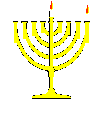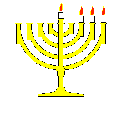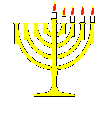| |
November 2013 Chanukah |
|
| Browse our
|

Quick Guide to Lighting Chanuka Candles By Jmag Staff
Quick Guide This year, 2013, (or if you want to be exact 5774) we begin to light the Chanukah candles on Wednesday evening, November 27, 2013 even though the first day is on the morrow, Thursday, November 28. Why is this? Because we Jews can never do anything like anyone else. Everything is complicated and so to confuse the goyim we celebrate it at night the day before. (Not really: this is a joke, laugh: ha ha. The real reason is that the Jewish day starts when the sun sets not at midnight or when the sun rises. Why? Oy, why do you ask me so many questions??) What time should we light up? The normal time for lighting the Chanukah candles is just when it begins to get dark, except for Friday night. See the next section for lighting when Chanukah falls on Shabbat. Candles lit in the day are not noticeable. Many families wait until all of the family members have assembled and then light the candles. When Chanukah is on Saturday night, we wait until after conclusion of the Shabbat, which ends with the Havdalah service to usher out the Shabbat, and then we light the Chanukah candles. What Am I Supposed to do for the Shabbat? On Friday, light the menorah before it gets dark. The Chanukah candles should be lit immediately before the Shabbat candles are lit, and if not, close to the Shabbat candle lighting time. They should burn for at least a half hour after it is dark outside. Where should the candles be lit? The place for lighting is based on the principle of spreading the light. Meaning that we spread the light of the miracle of Chanukah to others by putting the menorah in one of three places:
How are the candles lit? The first night, the first candle is lit. It is the candle on the extreme right of the menorah. On the second night, the second candle (the new one) is lit first and then the one which was lit the previous night is lit. The same is true for the successive nights, the new candle is given preference over the candles that have been lit, just like you should give preference to a new guest who is visiting you over a guest who has been by you many times before.
What is the Shamash?
The shamash is the candle which is
used to light the other candles. It is not one of the Chanuka
candles, yet it is not blown out but set in a place elevated above
the Chanuka candles. The light of this candle may be used for
lighting other candles, whereas the flame of the other candles
may not be used for lighting other Chanuka candles. Simliar to
the principle of he who serves is elevated. Who should light the candles?
It was traditional for the head
of the house to light the candles. In recent times, many young
boys have started to light their own menorahs. (Keep an eye out
for FIRE HAZARDS !) Although women and girls generally let the
men do the lighting, if no man is available to light, then the women should do
the lighting. Women generally light the Shabbat candles, men generally
light the Chanuka candles. What are the Blessings?
Before you light the candles, make the appropriate blessings. If you don't know them, click here to for the Chanukah Blessings. What if the candle goes out?
The Chanuka candle is supposed to
burn for at least a half hour. If it went out before the half
hour has past, relight it. If the half hour has elapsed, then
it's dependent on your desires: if you want to light it, then light it and if you don't wish to light it, then don't. What is traditional to eat? The most traditional foods are either latkes (potato pancakes) or sufganiot (jelly filled donuts). In Israel, the sufganiot are very popular, but in the Diaspora the latkes remain a staple tradition. For recipes click here.
In addition, milk dishes are popular as part of the miracle came from eating
cheese as related in another article. For much, much more on Chanukah, check out our Channukah Archives from the November 2013 Edition of the Jewish Magazine Material and Opinions in all Jewish Magazine articles are the sole responsibility of the author; the Jewish Magazine accepts no liability for material used. |

|
| All opinions expressed in all Jewish Magazine articles are those of the authors. The author accepts responsible for all copyright infrigments. |







